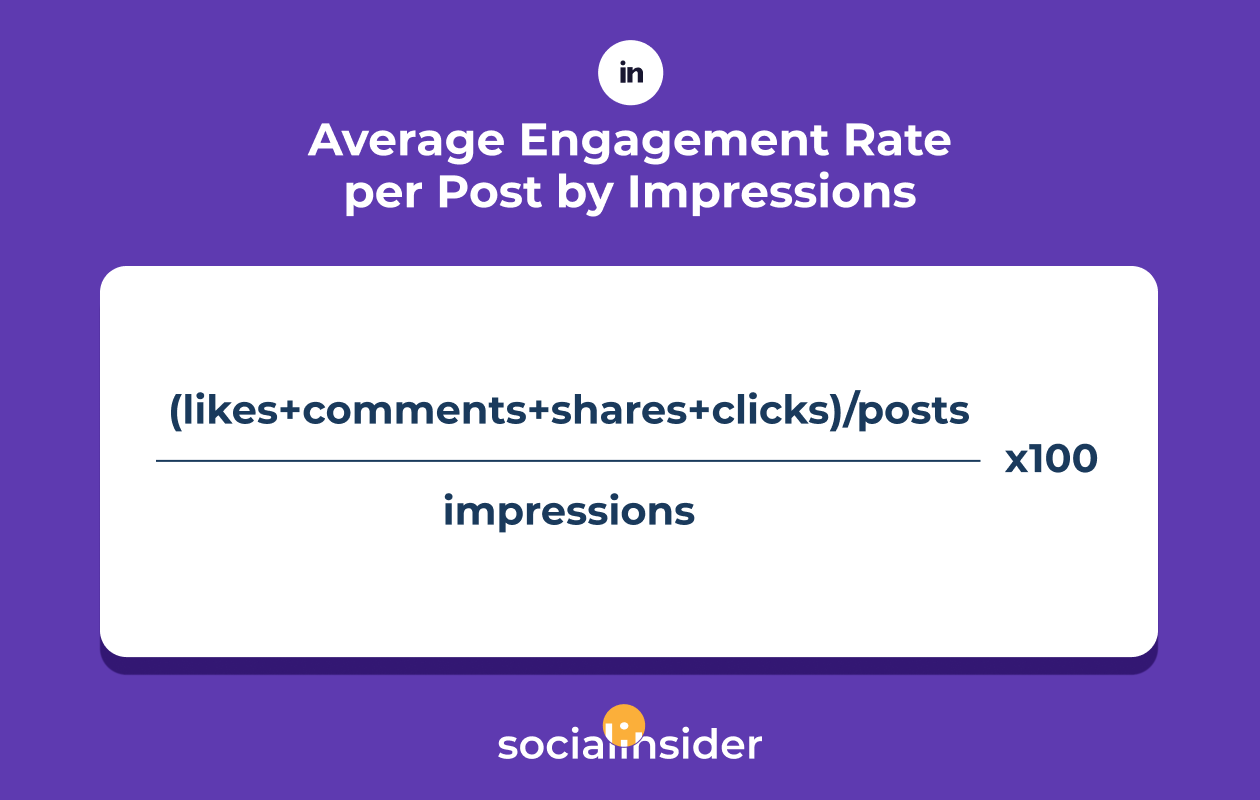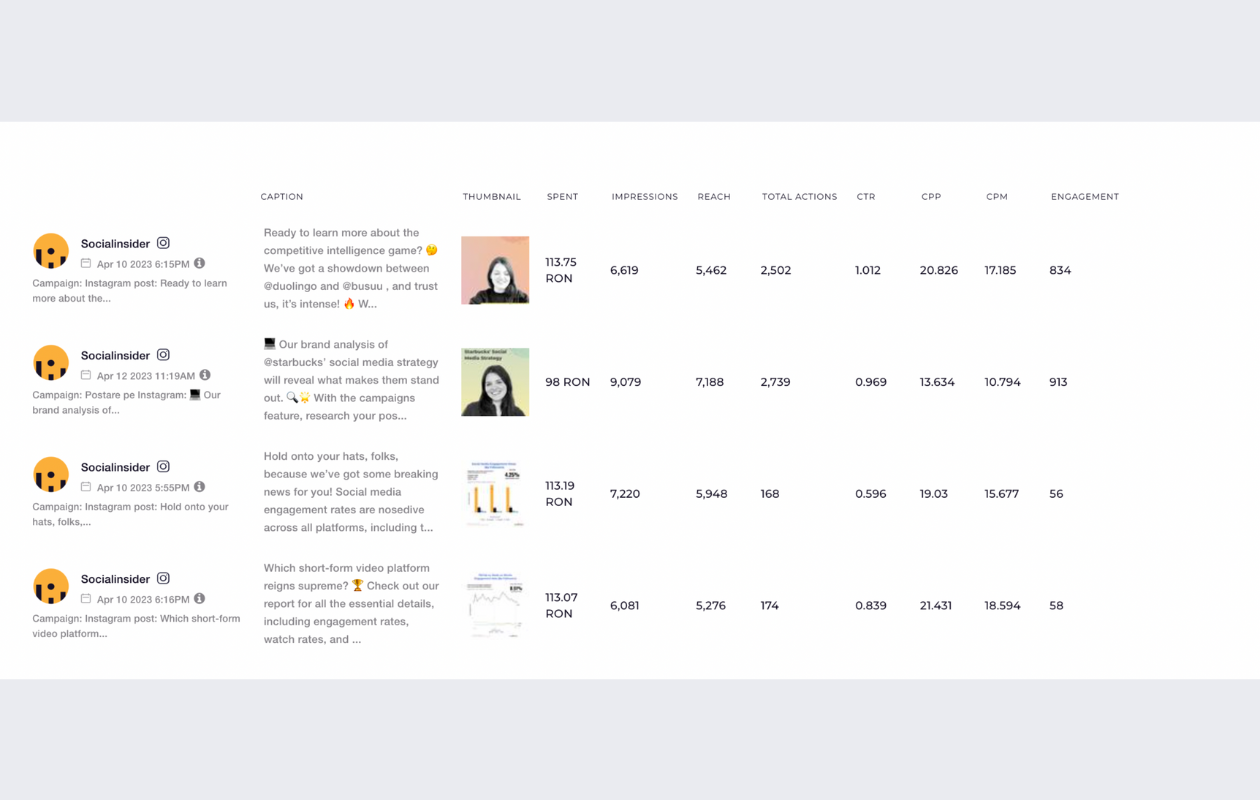In a far, far away land called Social Media, Metrics was the ruling family. And everything was well and prosper as long as the Social Media Manager was using Social Media Analytics to keep away the ugly dragon of Low-Engagement.
As a digital marketer, maybe you’re not always smitten by this kind of fairytales, but you know for sure that success on social media depends on always keeping an eye on the social media metrics.
Today we’re going to show you which are the most crucial social media metrics, why you should check them and how Socialinsider can ease your work.
Let’s dive in!
All the social media metrics that matter in 2023
1. Why checking your social media metrics is important
2. How to analyze top social media metrics with Socialinsider
2.1. Awareness metrics
1. Brand mentions
2. Follower growth
3. Reach
4. Impressions
5. SSoV or Social Share of Voice
2.2. Engagement metrics
1. Total engagement
2. Engagement rate per post by followers
3. Engagement rate per post by reach
2.3. Conversion metrics
1. Conversion rate
2. CTR or Click-Through Rate
3. CPC or Cost per Conversion
4. CPM or Cost per Thousand Impressions
5. Bounce rate
2.4. Customer care metrics
1. Customer reviews/testimonials
2. Customer response rate
3. Customer response time
4. Customer satisfaction
2.5. ROI metrics
1. Top referring social channels
2. Revenue from social channels
1. Why checking your social media metrics is important
Regardless whether you’re in the middle of an unfolding marketing campaign or you’re just getting started, building the pillar for your marketing strategy, you know you have to look at data to anticipate your next steps.
Social media platforms are continuously changing, with a bunch of updates, algorithm changes and new features all the time.
That’s why you have to keep an eye on social media metrics to anticipate your next move when you plan your content strategy for your platforms.
Otherwise, how would you know how your brand performs on social media?
Think of social media metrics like they’re a doctor that take their patient’s pulse (namely the social media campaign’s performance).
If you don’t know whether your patient is alive, you don’t know what’s aching and what treatment they need.
The effectiveness of a digital marketing strategy lies in the values of your social media metrics.
And they need to be high like kites to make sure your brand is gradually growing.
By checking social media metrics, you make sure your brand is getting the progress you worked for.
In case something from your marketing strategy doesn’t work for you, your metrics will signal it.
Even if every social media platform provides some native analytics data, they are not offering you the insights you need for the most important metrics.
And that’s when you need a social media analytics tool that showers you with a bunch of data.
2. How to analyze top social media metrics with Socialinsider
Socialinsider is more than an analytics tool, featuring data for benchmarking, competitive analysis and campaigns’ performance.
To have a clear picture in mind, we’ll analyze social media metrics from all social media platforms.
To do so, I added in our tool the social media platforms for Socialinsider and we’ll use the analytics tool to look at metrics.
In Socialinsider, you'll get data for Business Accounts on social media platforms like Facebook, Instagram, LinkedIn, TikTok and Twitter.

By jumping from one platform to the other, you will see the key metrics, but also specific metrics, depending on the social media channel you choose.
The key metrics you get for every social media network include:
- Engagement metrics
- Impressions
- Reach
- Top posts
- Followers growth

A close analysis of the most important metrics helps you measure how fast your brand is growing and what you should focus on to fuel its growth.
By adjusting the message you want to convey to your audience about your brand and creating content designed to cater their needs is what will make a difference and increase the values of your social media metrics.
But first, let’s categorize all social media metrics into bigger clusters.
2.1. Awareness metrics
These social media metrics focus on your current and potential audience. Consider checking these awareness metrics when you develop your next social media report.
1. Brand mentions
This metric refers to the overall number of mentions your brand gets online in a specific timeframe.
To make a better sense of this metric, you need to go to your Facebook page in Socialinsider, in the Overview section and look at mentions.
I’ve selected the last 12 months and I looked at brand mentions on Facebook for Socialinsider. Here is what I’ve discovered.

With Socialinsider, you can see your brand's mentions on Instagram and Facebook.
These in-depth details about mentions help you learn when users mention your brand and what is the context of their mention.
It's a pretty underrated feature although it can give you a lot of insights and ideas on how to address your community and why you need to improve your customer support.
Tracking mentions is part of your social media audit, helping you get a clear image of how users perceive your brand, products and services.
2. Follower growth
As a marketer, there's no greater social media notification than the one showing that you have some more extra followers.
However, what’s more important is who your followers are. If you sell roses and most of your followers are not interested in flowers, having more followers isn’t helpful.
Depending on the network, you can learn about age, income, interests, social habits (such as time of day they are active), profession, and more.
Ask yourself: Does this audience match up with what I’m trying to accomplish? Are they interested in my products and services? How can I stir up their curiosity with my products?
This is how the followers growth looks like for the last 12 months on Facebook for Socialinsider.

By tracking this metric on an extended period of time, you get to understand how many people resonate with your content.
You may notice that, from time to time, this metric can vary. Maybe some users followed you for s specific purpose, like a giveaway, and then they've decided to unfollow.
In case your followers growth dropped recently, it is a sign that you have to rethink your content strategy in order to offer them exactly what they're looking for.
3. Reach
Reach is an actionable metric since it’s directly influenced by timing (when is your audience most active?) and content (what does your audience find valuable in your post?).
This metric accounts for the total number of unique users who have seen your post since it went live.

In Socialinsider's dashboard, you can see a whole list of in-depth metrics related to reach, meant to help you split reach between organic and paid content.
The fact that you can see your reach by post type helps you learn on which type of content you need to focus more. The one with the highest reach is clearly the type of content that attracts your audience more.
4. Impressions
Next, we scroll to Impressions metrics. Impressions refer to the number of times your content has been displayed, whether it was clicked or not.
This social media reporting metric tells you that your content has been shown in someone’s feed.

A viewer doesn’t have to engage with the post for it to count as an impression. If they watch your video several times in a row, each view will also count as an impression.
The higher the number of impressions your posts get, the more suitable they are for your audience's needs and interests.
Sometimes, it might come in handy to filter Posts by impressions, particularly when it comes to platforms that prioritize this metric, such as LinkedIn or Twitter.
In Socialinsider, you can do this by heading to the Posts newsfeed (or Tweets, for Twitter) and clicking on the Sort button to open a dropdown menu. From there, you can select Impressions to get the top tweets by impressions:

5. SSoV or Social Share of Voice
SSoV measures how many people mentioned your brand compared to your competitors.
There are two categories of SSoVs:
- Direct - by tagging your posts through posts (e.g. @Socialinsider).
- Indirect - simply mentioning your brand without a tag (e.g., “Socialinsider”).
2.2. Engagement metrics
Engagement is the king of social media metrics. This metric gets split into a lot of other in-depth metrics that can help you craft better content, accustomed to your audience.
This is a big umbrella category to track. Think about engagement metrics in terms of how many people are interacting with your content. Engaged consumers interact with a post through likes (or other reactions), comments, and shares.
A high engagement rate means people really like what you’re posting.

Using an analytics tool like Socialinsider, you can keep track of your engagement reports for your business and understand how your brand performs on social media platforms.
6. Engagement rate
Total engagement represents the sum of interactions, shares, and comments for the posts published in a specific timeperiod.
Engagement rate is calculated as total engagement divided by the total number of followers, all multiplied by 100.
The breakdown for engagement is by followers, by impressions, and by reach.
-
The engagement rate formula for Facebook
When it comes to Facebook, social media managers usually report engagement by followers since the engagement by reach is only available for the owned accounts.
The engagement rate by followers on Facebook is calculated as reactions+comments+shares divided by the total number of followers, all multiplied by 100.

-
The engagement rate formula for Instagram
On Instagram, you’ll encounter the same situation with the engagement rate by followers as on Facebook.
The engagement rate by followers on Instagram is calculated as likes+comments divided by the total number of followers, all multiplied by 100.

-
The engagement rate formula for Twitter
The engagement rate by followers on Twitter is calculated as likes+retweets divided by the total number of followers, all multiplied by 100.

-
The engagement rate formula for LinkedIn
The engagement rate by followers on LinkedIn is calculated as likes+comments+shares divided by the total number of followers, all multiplied by 100.

7. Engagement rate per post by followers
This metric divides the average engagement by the number of followers the page has, all multiplied by 100.

8. Engagement rate per post by reach
Engagement rate per post by reach is calculated as the percentage of likes and comments divided by the total number of posts for a specific time, divided by reach, all multiplied by 100.
If you want to get more data that could help you see which type of posts brings more engagement, you should also check engagement by post type.
By seeing this split depending on the type of content you post, you will know on what to focus your marketing strategy.

We have this article about engagement rate for all social media platforms and I think that it could be a great help for you if you want a more in-depth analysis of this metric.
2.3. Conversion metrics
You define what a conversion is. At the middle of the funnel, it might be a request for information; at the end of the funnel, it’s probably a sale.
These social media reporting metrics define how efficient your social engagement is. So you might want to ask yourself - How much of my social activity generated a conversion?
9. Conversion rate
It represents the total number of users who take a desired action after clicking on a link in your post.
The conversion actions can be defined as the ultimate action you’d like users to take on your site: downloads, registrations, subscriptions, installations, etc.

In your Paid section from Socialinsider, by selecting your ad account, you can easily check metrics like CTR, CPP and CPM.
10. CTR or Click-Through Rate
CTR takes the number of clicks a post gets and divides it by the number of impressions.
A low CTR means you have a high number of impressions and a low number of clicks – and that your content isn’t resonating with the audience.
11. CPC or Cost per Conversion
When all is said and done, how much did it cost to get that conversion? Take all the costs of the social media campaign and divide it by the number of conversions you got.
If you spend $1,000 and get two conversions, your CPC is $500. If your profit is $300, you have some work to do.
12. CPM or Cost per Thousand Impressions
CPM is the amount you pay every time a thousand people scroll past your sponsored social media post.
13. Bounce rate
This social media metric measures the percentage of users who clicked on a link in your social media post, but quickly left the page without taking any action.
2.4. Customer care metrics
We talked about the performance of social media posts and overall social activity, but what about your customer’s experience with your brand?
This is where customer care KPIs come in.
These social media metrics cover the most crucial stage of the customer journey. They measure how your active users feel and think about your brand.

14. Customer reviews/testimonials
These include any positive or negative reviews, comments, assessments, or endorsements your brand received over a specific period.
This is a really important social media metric to track. If your customers are happy with your product, chances are they will share their positive experiences with others.
15. Customer response rate
Social media is one of nowadays' customers' preferred channels of communication with a brand.
While sometimes the number of comments and messages received may get overwhelming, it's important to answer every last one of them - or at least to as many as you can.
TIP: If you're one of those brands that get an incredible amount of messages and comments and you haven't done it by now - you should consider getting a community manager.
Let us explain a bit here - a community manager is in charge of supervising and replying to the community's questions and messages.
Back to the customer response rate - this particular social media metric quantifies how many of the messages received on your social accounts you have replied to.
Here's how to calculate it: divide the number of replies you've given by the number of people who engaged with your page and multiply it by 100.
16. Customer response time
If the customer response rate calculates how many customers have received a response from your brand, the customer response time shows how faster those messages and comments receive a reply.
Obviously, the faster you offer a reply, the better.
On social, people usually expect to receive a reply from a brand within a couple of minutes.
What surpasses this time window starts to be considered a poor response time and threatens to affect a brand's image and its relationship with its customers.
17. Customer satisfaction
As the name itself suggests, this metric tells you how satisfied customers are with a certain product or service.
2.5. ROI metrics
Some of the social metrics presented so far are applicable exclusively for social media marketing and are more first-base social media reporting metrics.
However, if you want a more in-depth understanding of your social media efforts are paying off, you should also keep an eye on other additional, but equally important social media metrics.
ROI is THE number one metric any brand focuses on in any kind of marketing initiative. That’s because it’s the best indicator of what generates success and business growth.
Drifting from this metric, there are a couple of less analyzed social KPIs that can offer helpful insights for an improved social media strategy.
18. Top referring social channels
Getting traffic is one of the most important marketing objectives for many businesses. Mainly because when landing on the websites, customers are one step closer to buying the company’s products or services.
The top referring channels social media metric indicates what those social platforms that are most successful in driving traffic to your website are. All this data will be available to check anytime you want in your Google Analytics account once you set one.

By knowing this info, you’ll be able better to optimize your social media strategy in the future and focus on those social channels that are more likely to help you increase your sales and grow your business.
19. Revenue from social channels
This is one of those social marketing metrics that will make managers and business owners listen very carefully when presenting your social media ROI report.
Of course, other metrics for social media marketing like followers, traffic, conversions, and so on also matter a great deal.
However, in the end, to prove the value of your social media work, the revenue from social channels is the ultimate social media metric that should be monitored and presented.
The key to doing excellent social media reporting is to analyze the most important social marketing metrics for every marketing funnel stage.
By constantly monitoring this social media metric, you’ll be able to shift your resources investment towards creating content for those particular networks that give you the best ROI.
Final thoughts
To make sure you don’t miss out on any important social media metrics, you have to focus on those that bring you closer to success.
These social media metrics can help you better craft and adjust your marketing strategy according to your performance in a pre-established time frame.
With the insights your get about every metrics through the use of a social media analytics tool, you can build complete reports, develop competitive analysis and benchmarking.








